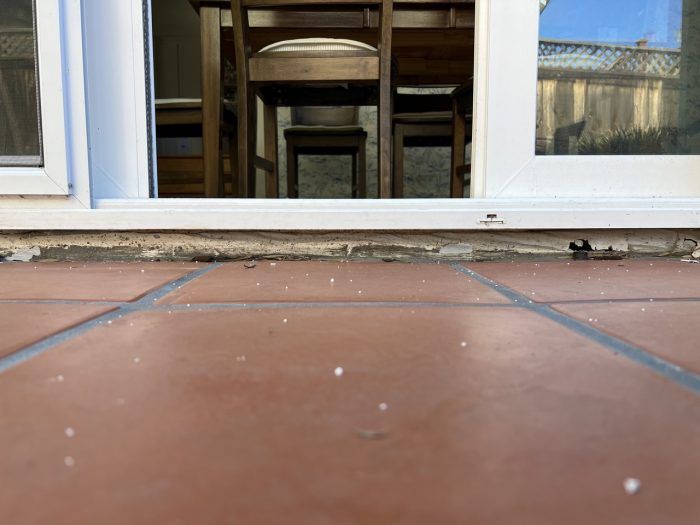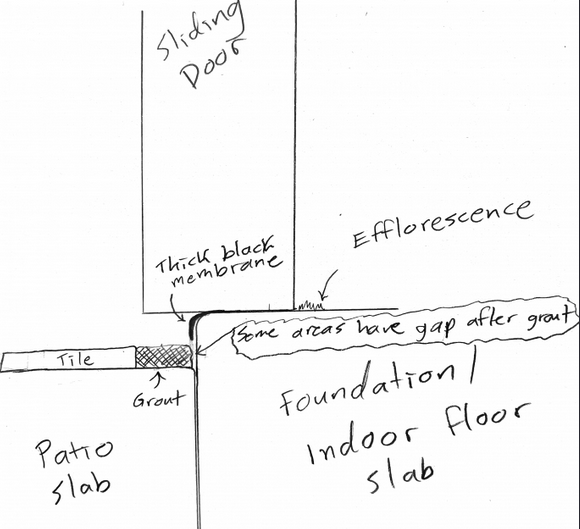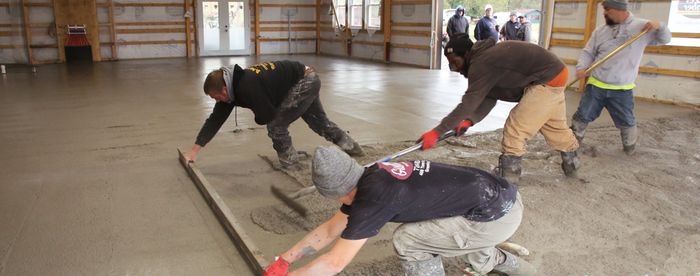Moisture Issues from an Outdoor Concrete Slab
Moisture is migrating inside from an adjoining patio slab. Can the connection be waterproofed?

Two adjacent concrete slabs are causing unexpected problems for Aaron Schwartz.
His house is built on one of the slabs. The second is just outside, underneath a tiled patio. The issue? Water collecting on the outdoor concrete slab is apparently wicking into the interior slab and showing up as efflorescence on Schwartz’s dining room concrete floor.
“I know this would have been much easier to address before the patio slab was poured,” Schwartz explains in this recent Q&A post. “But since the damage is already done, I’m trying to do the best I can to retroactively make it a little better.”
His first thought is to chip back some of the grout separating the two slabs and coat the entire area with some kind of elastomeric membrane or liquid flashing product.
“I would let some of it seep down between the back of the grout and the indoor slab,” he says. “I don’t think I can do anything if water gets below that patio level and makes its way down and under any waterproofing.”
Alternately, he has considered applying a penetrating sealer to any exposed concrete and grout. Once the area is waterproofed, Schwartz would apply lath and stucco beneath the patio door to match the rest of the wall.
Is that a good plan? That’s the topic for this Q&A Spotlight.
Use a self-leveling caulk
Calvin thinks moisture could be wicking up under the door threshold or traveling slab to slab.
He’s not convinced that Schwartz could dig out the grout separating the two slabs deeply enough to prevent moisture from wicking inside. But, he adds, using a self-leveling sealant such as Sika’s Sikaflex might be worth a try.

“If I were to use any premium caulk in that joint, it would be self-leveling,” Calvin says. “It has a chance of being nasty, as it will flow like thick water in its attempt to self-level. It won’t be quick. But you apply it, and some will go down to China (till it’s stopped) and run out any undammed end or, worse, overflow onto your tile. We often use foam rope to pack openings or deep holes, prior to the sealant.”
He suggests practicing with a mini mock-up if Schwartz has never used the product before.
“Once you’ve got that taken care of, use a piece of PVC trim suitable in look, size, and shape to fill the area under that threshold,” Calvin adds. “You want a good fit so your threshold doesn’t get worked up and down from using that door (but not too tight to affect the door travel). Use a urethane caulk both under and behind to seal against further intrusion.”
Make a cut in the patio slab
A reader named mgmahan suggests making a saw kerf in the patio slab as close to the house as possible and as deep as possible.
“Then you should be able to remove the patio slab next to the house slab,” mgmahan says. “This will give you a lot of options for waterproofing the edge of the house foundation.”
Even if the cut is several inches away from the house and the patio tile has to be cut, he says, that shouldn’t be a problem. Just put a new piece of tile next to the house with a grout line at the saw cut. If the new tile doesn’t match exactly, that’s OK. Schwartz can create a border.
BobBlack agrees that making a deep, vertical cut on the patio is the best answer here.
“Fill it with liquid waterproofing—any suitable bitumen-based,” Bob says. “And if you heat it up, it will flow well down the kerf.”
Matching the stucco house finish
Schwartz understands the suggestion about a fill strip under the door threshold, but he’s concerned that a strip of PVC or similar material will not match the stucco on the rest of the house. After waterproofing the area, he’d rather add some lath and stucco to bring the surface flush with the lip of the door sill.
“I know the stucco isn’t waterproof, but I think it would shed the majority of the water,” he says, “and any water that soaks into it would be blocked by the sealants behind it.”
Calvin, however, suggests that Schwartz be careful that the door sill, which overhangs the slab, isn’t under too much stress as people go in and out of the house.
“I would advise my customer to put something under that pressure point,” Calvin says. “If stone wouldn’t snap or crack, that might be an option.”
He suggests that Schwartz ask the door installer for suggestions, but that’s apparently not in the cards.
“We’re not on good terms with our remodelers, since we’ve had poorly designed construction details like this that we have to deal with,” Schwartz says. “I wouldn’t trust them to provide a correct solution.”
Our expert weighs in
Josh Salinger had this to add:
Efflorescence is caused by water containing dissolved salts wicking via capillary action through a porous material such as concrete, masonry, or brick. The salts are deposited within and on the evaporating surface of the material. As the material gets more and more concentrated with salts, water—via osmosis—wants to travel to this area. This pulls even more dissolved salts to the area, creating a vicious cycle that, over time, can lead to aesthetic issues or failure of the material, known as spalling.
The salts are usually found in the soils around concrete or masonry, but they can also be found in the materials themselves. The capillary suction of concrete is remarkably strong; a 1-ft.-dia. column of concrete can wick water upward 6 miles before the weight of the water counteracts the force of the capillary action. This strong capillary pressure is what can damage concrete as it pushes water toward the high-salt areas. That hydrostatic pressure can overcome the strength of the concrete itself.
There are essentially two main ways to mitigate efflorescence. One is to keep salt-laden water away from the porous material or otherwise stop the migration of water. The other is to allow it to do its thing but strategically have the salts deposited in a sacrificial material that can be easily replaced. For the former, a capillary break such as a polyethylene sheet under the slab coupled with a capillary break between the footing and stem wall and dampproofing the exterior of the foundation wall creates a continuous capillary break. The latter is commonly seen as a parge coat over brick or masonry foundations or walls wherein the salts accumulate until the coating fails and falls off. This sacrificial coating can be replaced every few decades, as is the case with European brick-and-stucco buildings.
Efflorescence occurs more often in concrete that is more porous and/or less dense. A high-strength concrete is more dense and has less capillary suction. Additionally, concrete with higher alkalis can lead to more efflorescence. Sometimes the way the concrete was finished can lead to less dense areas, such as along the perimeter of slabs, which is where the issue is occurring on Schwartz’s slab.
Since the slab and patio are already in place, there is only so much one can do at this point. That being said, there are a few high-level mitigating actions to look into straightaway. One is to keep bulk water away from the home by using some sort of awning or covering with gutters directing the water away from the home; the other is to be sure that the grade is sloping away from the home and a foundation drain is in place and is being daylighted to move bulk water away from the foundation. Keeping the area and the soils around it dry will be priority number one.
Beyond that, try to stop the water from being wicked into the foundation in the first place. That is difficult in this situation due to the relative inaccessibility of the two slabs. The least invasive and most cost-effective, although least durable, solution would be to place sealant superficially at the top of the joint where the two slabs meet.
If this approach is considered, I would seal the joint with a silyl-terminated polymer (STP) such as Prosoco Joint and Seam filler. It’s fiber-reinforced and durable, and it can be tooled to create a slope that directs water away from the building. This could be coated with a fluid-applied water barrier such as Prosoco R guard that would go from under the door, down over the tooled sealant, and slightly onto the brick patio. Calvin’s solution goes a bit further in that the self-leveling sealant is poured into the crack and attempts to create a physical capillary break between the two slabs. These two solutions could be combined, which would keep water out and also help break the capillary action between the two slabs.
One thing I would caution with Calvin’s approach is that one wants to allow for water to escape below the door threshold. Sealing from the patio to the bottom of the door could lead to trapped water should it get below the threshold, which is really just a matter of time. One would just want to use the PVC board as an aesthetic device to cover the gap and sealants and to allow for water to drain out.
Another way to stop the migration of the salts to the inside would be to seal the concrete on the interior. A two-part epoxy, Class-1 vapor barrier such as SureCrete’s DK 700 or similar can be applied to the slab, effectively stopping the movement of salt-laden water to the interior. In this case, the concrete would reach equilibrium moisture content with the ground (the concrete doesn’t care) and would be separated from the inside of the building by the liquid-applied vapor barrier. This would stop the deposition of the salts on the interior, but it would require that the entirety of the slab be treated, which would have an aesthetic impact to the interior of the building.
Schwartz also could encourage the deposition of salts to the exterior of the building by adding a sacrificial layer of stucco to the exterior, under the door. Schwartz had mentioned wanting to match the stucco on the house, so from an aesthetic perspective this could solve two problems at once. He should expose the bare concrete slab edge so that running a wire brush attachment on an angle grinder would remove any of the bituminous layer. Once this was removed, one could apply lath and a non-polymer-modified (traditional) stucco, or a lime mortar. This parge coat would attract the salt-laden water and encourage the deposition of the salts toward it instead of to the interior of the building. This could be a relatively low-cost mitigation strategy, but it would require constant replacement over the decades, as it would eventually fail—if it is doing its job. Again, it’s important to encourage any bulk-water leaks from the door threshold to drain to the exterior.
Taking things a bit further, Schwartz could cut the patio slab and remove it down to native soils, similar to what mgmahan suggested. This would be the most labor intensive and costly option but would likely yield the best results. The idea of creating a border is a good aesthetic solution and would allow plenty of space to make the cut and remove the patio slab. Once that was done, the home’s foundation edge would be accessible, allowing the application of a damp-proofing material, typically an asphaltic emulsion. Manufacturers such as Henry and Tremco provide good options. Better yet, also include a dimpled membrane mat such as the Dorken Delta-MS, which would stop the capillary movement of water and provide a drainage plane, relieving any hydrostatic pressure. In this instance, Schwartz should install a foundation drain and gravel capillary break using 3/4-in. minus gravel or larger with no fines. Once this is installed, he could repour the slab and install either the same tile or a border to finish it up. Without any way for the salt-laden water to reach the interior foundation, the efflorescence shouldn’t be a problem.
Scott Gibson is a contributing writer at FHB and Green Building Advisor. Josh Salinger is founder and CEO of Birdsmouth, a design-build company in Portland, Ore. Reader comments may have been edited for clarity.
RELATED STORIES





